Dogecoin (DOGE) price prediction for 2024-2030
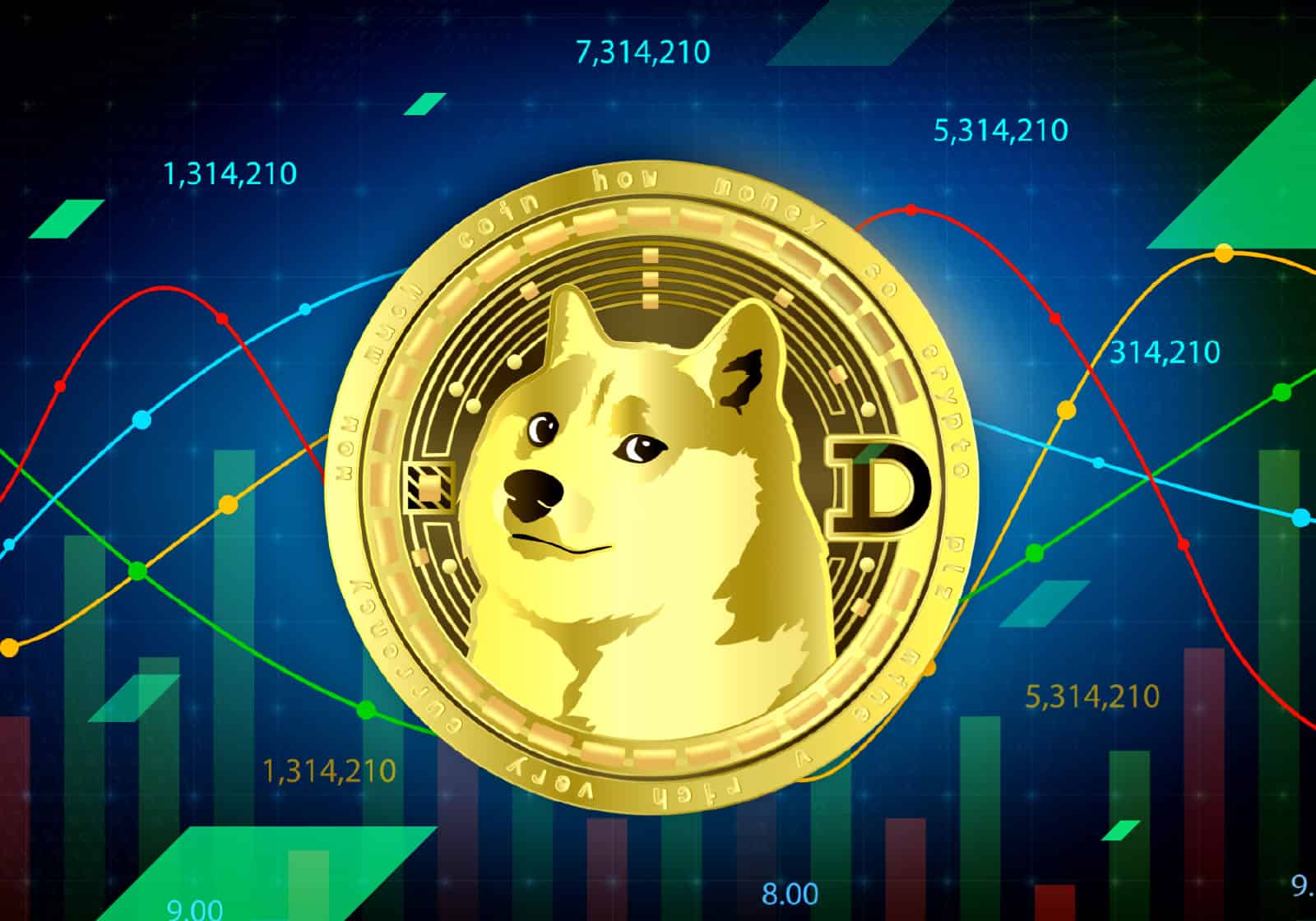
Dogecoin (DOGE) is a fairly unique cryptocurrency. While the creators of other cryptocurrencies and payment systems try to surprise and attract potential users with certain technological moves and innovative solutions, Dogecoin gained popularity in a completely different way. The developers used an image of a Japanese Shiba Inu dog as Dogecoin's symbol, a meme that flooded the Internet.
The creators' main goal was to amuse the crypto community in a sense. Nevertheless, Dogecoin quickly gained popularity and significantly increased in value, becoming one of the most popular cryptocurrencies on the market. In this article, we'll explore questions like 'What is Dogecoin?' and 'Does Dogecoin have a future?', as well as Dogecoin price predictions, the project's fundamentals and experts' price forecasts.
Dogecoin's origin
American programmer Billy Marcus created Dogecoin. His idea was to create a cryptocurrency that's affordable for every user, regardless of their financial capabilities, as an alternative to the expensive Bitcoin. In addition, the developer wanted to distinguish his creation from the controversial reputation of other cryptocurrencies. Another programmer, Jackson Palmer, who worked in the marketing department of Adobe Inc. in Sydney, also played an active role in bringing the project to fruition.
The Dogecoin blockchain was launched on 6 December 2013. Dogecoin's original total issue was planned to be limited to 100 billion tokens. However, over a year after the project's launch, the token's issuance reached 98 billion. That's when the creators decided to remove the limit and enable infinite token issuance. Approximately 5.5 billion new DOGE tokens are issued each year, which, according to many experts, harms its value and makes Dogecoin's future price very sensitive to inflation.
More of a joke coin, Dogecoin wasn't originally planned as a serious investment project. Nevertheless, the funny cryptocurrency quickly gained popularity and significantly increased in value, ranking among the most popular cryptocurrencies.

According to the creators themselves, Dogecoin is a cryptocurrency for the Internet community, and they don't aim to compete with the titans of the e-commerce market. However, the developers are constantly improving payment ease, expanding Dogecoin's adoption on the internet.
What is Dogecoin (DOGE)?
Dogecoin (DOGE) is a decentralised, peer-to-peer, open-source cryptocurrency derived from the Litecoin blockchain. Like most cryptocurrencies, Dogecoin is based on blockchain technology and functions on cryptographic principles using a proof-of-work algorithm. When a new block is formed in the chain, two cryptographic keys are created: a public and a private key. The public key allows users to view information about the block, while the private key provides access to the owner of the formed block.
Dogecoin is also a mineable digital currency. If you're looking for the best cryptocurrency to mine in 2020, please read our blog.
Dogecoin's block production rate is 6 minutes. Compared to other cryptocurrencies, that's pretty fast, making Dogecoin a great tool for payments and money transfers.

A key feature inherent in Dogecoin that fundamentally distinguishes it from most other cryptocurrencies is its inflationary nature. Most cryptocurrencies are deflationary. That means that most cryptocurrencies — Bitcoin, in particular — are structured so that their issuance is strictly capped to a certain amount of tokens that can go into circulation. For more detailed information on How many Bitcoins are in circulation, please read our blog article.
The main disadvantage of capping issuance is that it promotes and encourages the constant accumulation of coins, as their value is expected to increase significantly in the future. Another problem is that, with a significant market capitalisation and mining reward reduction (which decreases exponentially), miners will lose all incentive to support the network sooner or later.
Dogecoin applies a slightly different approach, relying instead on inflation. That way, new tokens can be mined despite their low value. Newly mined tokens replace lost tokens, thereby maintaining a steady supply of approximately one hundred billion active tokens. Since most Dogecoin users perceive this cryptocurrency primarily as a medium of exchange rather than an investment, an inflationary approach could lead to success.
Dogecoin has a consistent issuance rate of 10,000 new tokens per minute. According to its creators, the cryptocurrency's key goal is to keep 100 billion coins in constant circulation, meaning issuance continues after reaching this mark. Miners are rewarded accordingly. This keeps the necessary number of coins in constant circulation, compensating for lost wallets and coins.
How is Dogecoin (DOGE) different from other cryptos?
Although Dogecoin was derived from Litecoin's blockchain, which was developed by modifying Bitcoin's source code, DOGE varies a lot. Dogecoin shares most cryptocurrencies' common functional principles, such as complete network decentralisation, proof-of-work algorithm, and transaction processing methods. The key differences between Dogecoin and other cryptocurrencies are as follows:
- The Scrypt algorithm is used for data encryption on the network instead of the standard SHA-256, making this cryptocurrency very easy to mine without sophisticated equipment.
- Initially, the token issuance was capped at 100 billion, but the creators settled on an infinite issuance later on.
- The transaction fees are very low compared to fees in other networks. The amount is generally no more than $0.01, while in the Bitcoin network, the commission can reach $10.
- The transaction processing speed is high, thanks to a reduction in the block mining rate.
- Dogecoin's low cost allows anyone to buy in, regardless of the capital they have.
- Dogecoin has a practical application: network participants use it to pay for various goods and services on the Internet. In addition, Dogecoin operations are not banned, even in countries where Bitcoin cannot be used.
- Dogecoin can be mined without spending a lot of money or using complex, expensive equipment.
In technical terms, Dogecoin also has a range of differences from other cryptos, even though it is considered by many to be an exact copy of the Litecoin network.
- Dogecoin's block mining rate is 1 minute, while Litecoin's is 2.5 minutes.
- The transaction confirmation time is 6 minutes, while in Litecoin, it's 15 minutes.
- The block reward has been calculated randomly for some time and was quite unstable. Since 2014, the reward has been 100,000 coins and a percentage of the transaction fee.
Dogecoin's pros and cons
Among its pros, Dogecoin is a much better means of payment than, for example, Bitcoin, even though Bitcoin's main purpose is to be a payment method. Dogecoin is also a great way to make payments online. Other advantages that set Dogecoin apart from other cryptocurrencies include the following:
- Dogecoin perfectly fits investors who don't have enough capital to invest in more expensive cryptocurrencies. It allows newcomers to get to know the cryptocurrency market and gain the necessary experience.
- Dogecoin allows fast, cheap transactions.
- It has a very active community. The cryptocurrency, originally conceived as a joke, has functioned since 2013 and is gradually gaining popularity. It has seen stable, albeit slow, growth and even counts Elon Musk among its fans.
- Dogecoin ranks among the top 50 cryptocurrencies by market capitalisation, which suggests its high stability and trust.
- There are no problems with scaling, unlike most other cryptocurrencies.
- DOGE's transaction speed is very high and has extremely low commission rates.
- Many exchanges and online platforms support Dogecoin.

Another one of Dogecoin's major advantages is its high level of security. Decentralised systems undoubtedly provide much better security than their centralised counterparts because the absence of a controlling server ensures a greater degree of security. Sooner or later, blockchain will be universally recognised as the best technology today in user security. Dogecoin is one of the few networks that implement decentralisation; most cryptocurrencies have some centralised features.
Another important property that distinguishes Dogecoin from traditional payment and financial transfers is that, unlike the banking industry, transactions are managed only by the user. Consequently, no transaction can be cancelled for reasons beyond the user's control. It doesn't matter to whom or where funds are transferred or what goods are paid for; the transaction will go through in any case. However, Dogecoin does have its cons:
- Dogecoin has poor technical support. Its development team is not as big as the cryptocurrency market titans, and its aspirations are not so ambitious.
- Dogecoin's value is constantly fluctuating and difficult to predict. This statement is generally true for any cryptocurrency, but it's particularly evident with Dogecoin. Even with its self-stabilisation system, Dogecoin isn't immune from sharp fluctuations, which requires a thorough and extensive revision.
- Dogecoin gained popularity primarily due to marketing moves; it didn't offer anything unique or special in terms of technology. That makes this cryptocurrency very vulnerable as it vies for a prime place with more advanced, innovative competitors.
Of course, one of Dogecoin's main weaknesses is its initial humorous nature, which negatively affects its value growth. Apparently, the project's creators still don't know how to develop their child, so the network largely functions only thanks to its loyal users. This approach negatively affects the cryptocurrency's value and doesn't add points to its competitiveness.
Dogecoin (DOGE) price analysis
Over the years, Dogecoin's growing popularity has ensured demand on the market, which has allowed it to hold its position among the leading cryptocurrencies. As of 14 March 2024, DOGE was ranked 9th by market cap at $26,165,977,968. With a circulating supply of 143,462,416,384 DOGE coins, the cost of one Dogecoin token is $0.182. Here's an overview of Dogecoin (DOGE):
Dogecoin (DOGE) Price Today | $0.182 |
Market Cap | $26,165,977,968 |
Circulating Supply | 143,462,416,384 DOGE |
Daily Trading Volume | $4,255,111,663 |
All-Time High | $0.7376 (8 May 2021) |
All-Time Low | $0.000085 (7 May 2015) |
Official Website |
Dogecoin's (DOGE) price history
When Dogecoin was first listed on exchanges on 17 December 2013, it was priced at $0.000255. A month later, in January 2014, its price reached $0.002306, a nearly 10-fold increase. After that, it rolled back sharply and was at its lowest level in three years. In early June 2017, when Bitcoin and the cryptocurrency market were on the rise, DOGE reached a new high of $0.003575. Post-growth correction took Dogecoin to its pre-break-out support at $0.0008 on 17 September. After the correction, DOGE's price experienced astonishing growth, breaking through limits and reaching a high of $0.018773 on 7 January 2018.
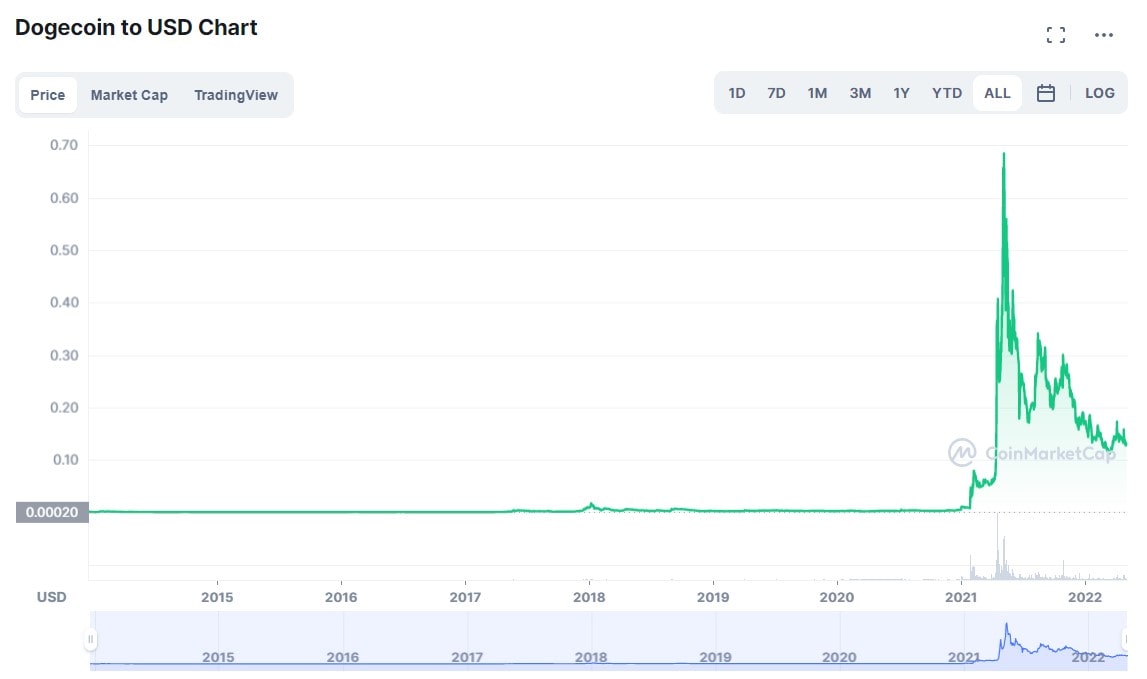
In Q1 2018, the entire crypto market took a hit, and Dogecoin fell to $0.002725 by 5 April. Its low price attracted buyers' interest, leading to its price rebounding quickly to $0.005806 on 20 April. Dogecoin's rebound was only temporary; its price fell back to $0.002282 on 16 August. Because wild swings are in this cryptocurrency's nature, an upside spike in September took Dogecoin's price to $0.006539, where the asset ranged for several days, only to fall again later. The rest of the year was bearish, and DOGE traded at $0.002222 on 31 December. In 2021, DOGE's price increased far more than ever before. It moved over 5000% from its previous high, setting a new all-time high at $0.7376.
In May 2021, the price of DOGE dropped after Elon Musk referred to it as a "hustle" during an appearance on Saturday Night Live. Despite predictions of the price exceeding $1, DOGE traded at around $0.30 by the end of May and fell further to $0.1607 on 20 July 2021. However, a summer rally brought the price up to $0.351 on 16 August before falling again to $0.1945 on 26 September. DOGE reached $0.2819 on 24 October but entered a downward trend along with the broader markets in 2022.
Starting the year at $0.1705, DOGE briefly climbed to $0.2032 on 14 January 2022 before dropping to $0.1272 on 24 January. It rebounded to $0.1716 on 7 February but couldn't sustain that level. On 13 March, DOGE dropped to $0.1107 before attempting to reach the $0.17 level on 5 April 5. However, the price plummeted to $0.07004 on 12 May due to the collapse of the terra luna cryptocurrency and the US dollar reaching 20-year highs.
With bearish sentiment prevailing, DOGE reached its lowest level since early 2021 at $0.04972 on 18 June. It traded within the $0.06-$0.07 range until a brief rally driven by retail investors on social media brought the price up to $0.08864 on 16 August. However, DOGE quickly dropped back to around $0.06.
The year 2022 ended with DOGE at $0.07029, but it experienced a recovery in January 2023, closing the month at $0.09617. It then slid to a low of $0.08017 on 10 February before climbing back to $0.09126 on 19 February.
On 3 April 2023, Elon Musk's Twitter account featured the Dogecoin emblem, leading to a rally where DOGE surged by more than 33% and broke past $0.10 for the first time in 2023, reaching a high of $0.1026.
The price of the memecoin dropped to $0.05 in June 2023 but rebounded to $0.07 by July's end, only to fall back to $0.05 by mid-August. A turnaround occurred in mid-October when buyers pushed the price above $0.07, reaching $0.10 in December before falling back to $0.07 by January 2024.
The bullish trend resisted for over a month, leading to a surge in February, with DOGE establishing $0.15 as support and $0.20 as resistance by March.
DOGE's market cap surpassed other cryptocurrencies like AVAX, TRX, and DOT. Social engagement rose alongside valuation, indicating a positive sentiment shift. Despite the potential for a $0.20 or even $0.28 peak, market overextension poses a risk of correction, though solid trading volumes and investor confidence may stabilise prices.
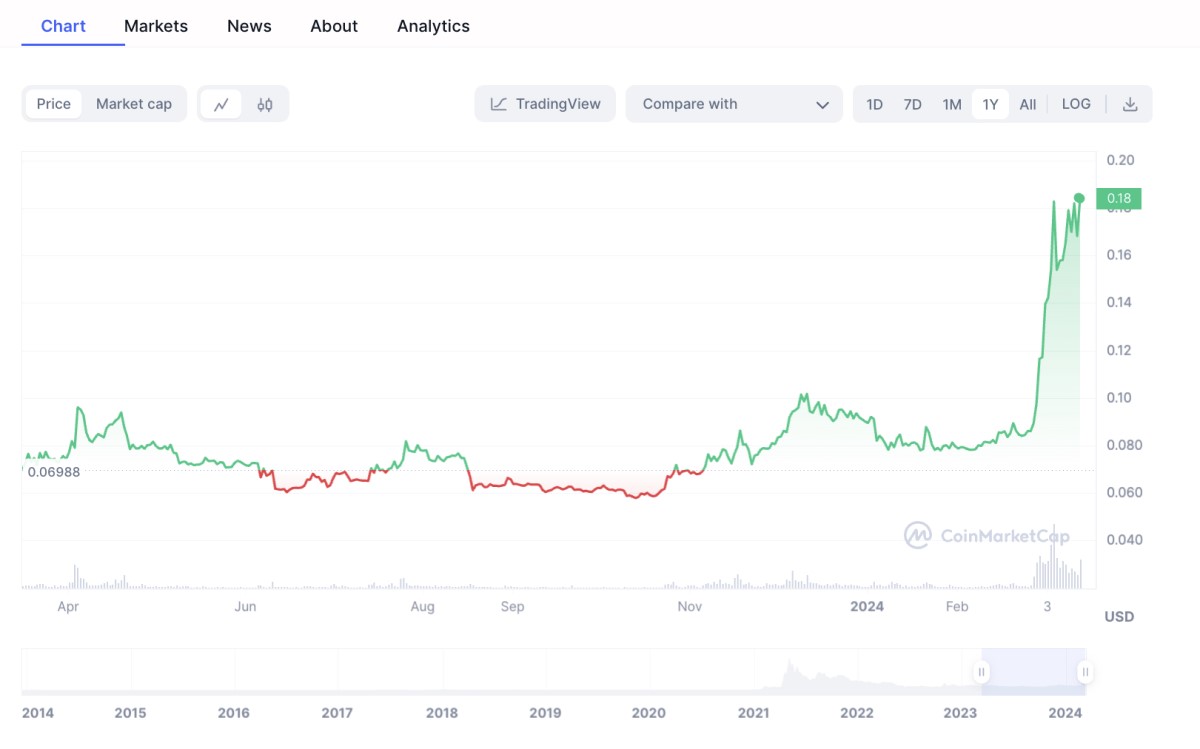
Dogecoin (DOGE) price prediction 2019
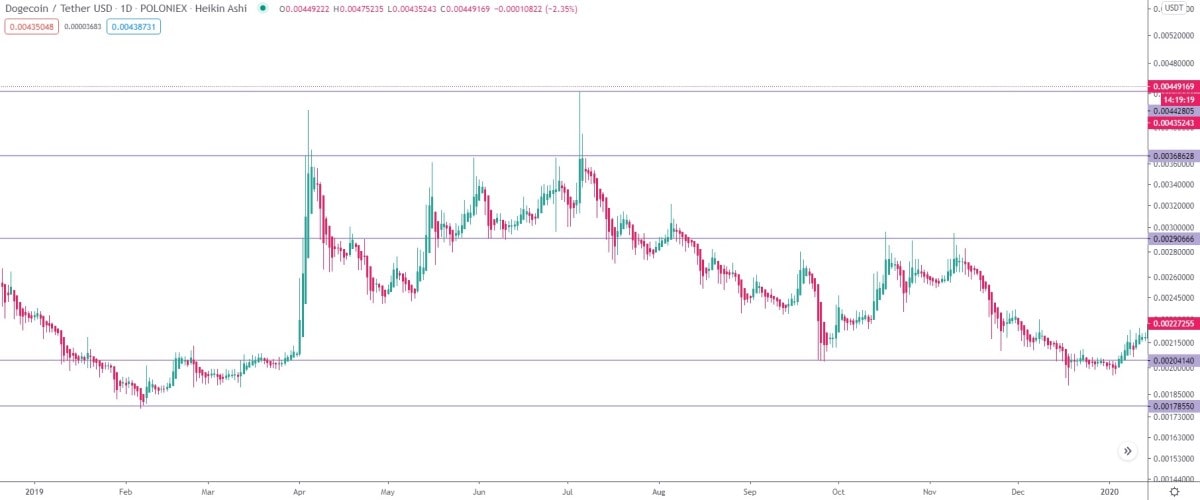
Dogecoin's 2019 price action offered nice volatility for traders. Despite the fact the price continued to fall until early February, later consolidating in the $0.0018-0.0021 range until 31 March, Dogecoin fully recovered from the drop in April. On 1 April, on the official Dogecoin Twitter account, users jokingly asked to choose a new CEO for the project. Among the candidates was Elon Musk, for whom the majority voted. Elon Musk expressed his favourability to the project, which heated DOGE's growth by taking the price to $0.004 on 4 April. A pullback followed that to $0.0024 on 9 May, from where the asset continued its bullish trend to $0.0044 on 6 July. Meeting resistance there, Dogecoin retested the $0.002 support level and immediately rebounded to as high as $0.0029 on 17 October. After multiple attempts to climb above that resistance level, the price plunged, closing out the year at $0.002.
Dogecoin (DOGE) price prediction 2020
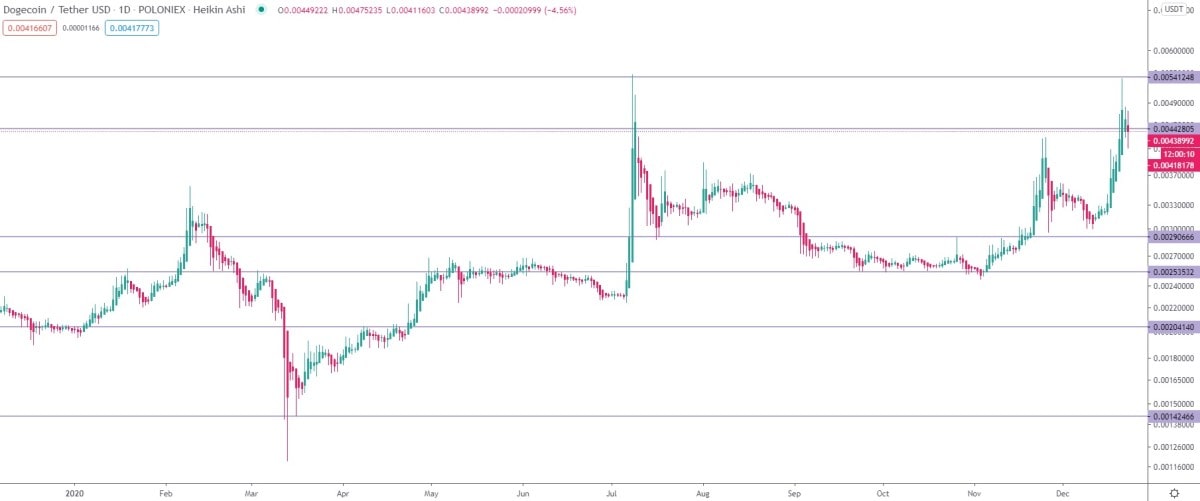
In general, 2020 was a good year for Dogecoin. In Q1 2020, DOGE's price performed well, rising from $0.002 in January to $0.0035 by 9 February. However, a pullback across all the markets led to DOGE's price drop, too. Dogecoin fell as low as $0.0012 on 13 March. The support level was well defended, and buyers were able to turn the trend in the bulls' favour, taking Dogecoin as high as $0.0054 by 8 July.
This was followed by a pullback to $0.0025 in early November, when the asset continued to grow, retesting its $0.0054 resistance on 21 December. Once again, Elon Musk added fuel to the growth, posting on his Twitter feed the following message: "One word: Doge".
Dogecoin (DOGE) price prediction 2021
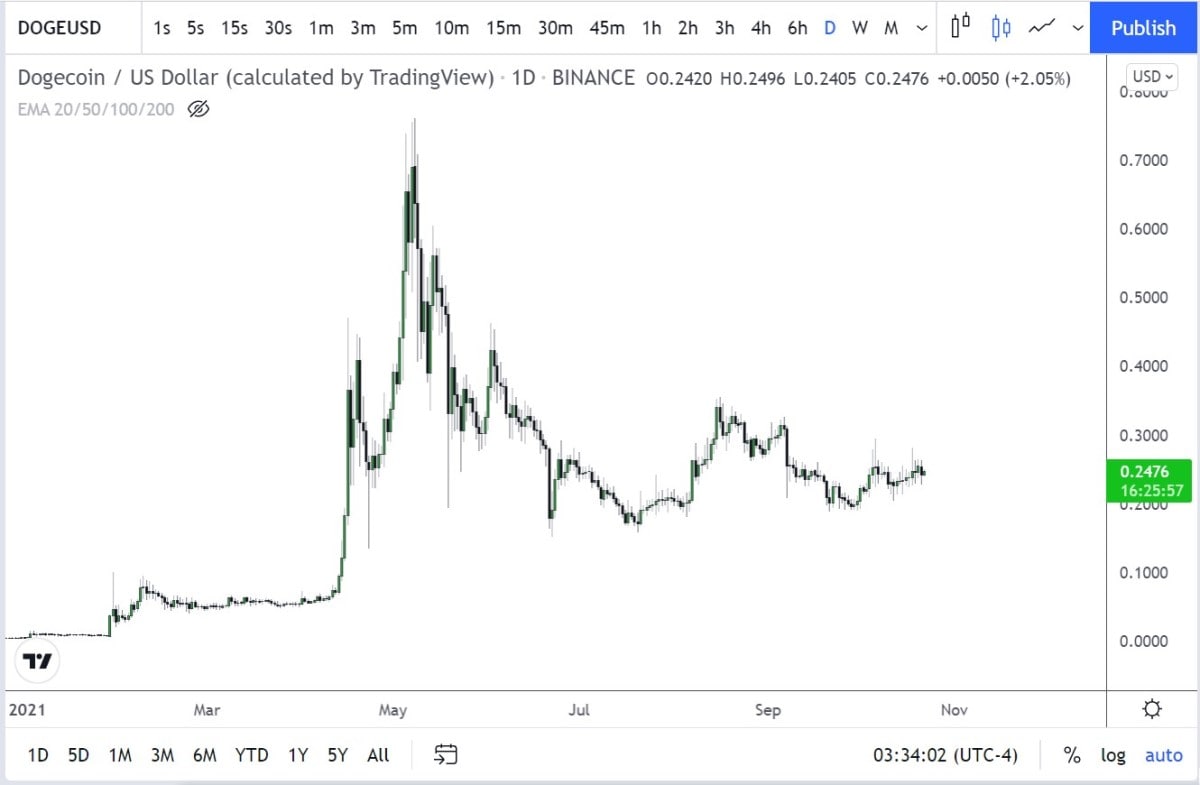
In 2021, the world's interest in cryptocurrency saw a marked increase. The year started out bullish for most coins, and crypto prices across the market moved rapidly higher. Dogecoin was one of those that benefitted the most from the crypto market's popularity. It rose in February, then consolidated until late April, when the real move began.
It also helped that popular figures like billionaire Elon Musk also took some interest in the coin. All that PR was good for DOGE, as it took every inch of price growth that it was allowed. On 8 May, Dogecoin reached a peak above $0.70 before the price began its descent. DOGE currently trades at around $0.13
Dogecoin (DOGE) price prediction 2023
Based on the technical indicators, it is predicted that the lowest price of Dogecoin in 2023 will be $0.0608, while the highest level it can reach is $0.0670. The average trading price is expected to be around $0.0731.
Dogecoin (DOGE) price prediction 2024
Based on the technical analysis, Dogecoin's price in 2024 is anticipated to range from a minimum of $0.0739 to a maximum of $0.121, with an average trading price expected to be around $0.168.
DOGE/USDT price chart
Dogecoin (DOGE) technical analysis
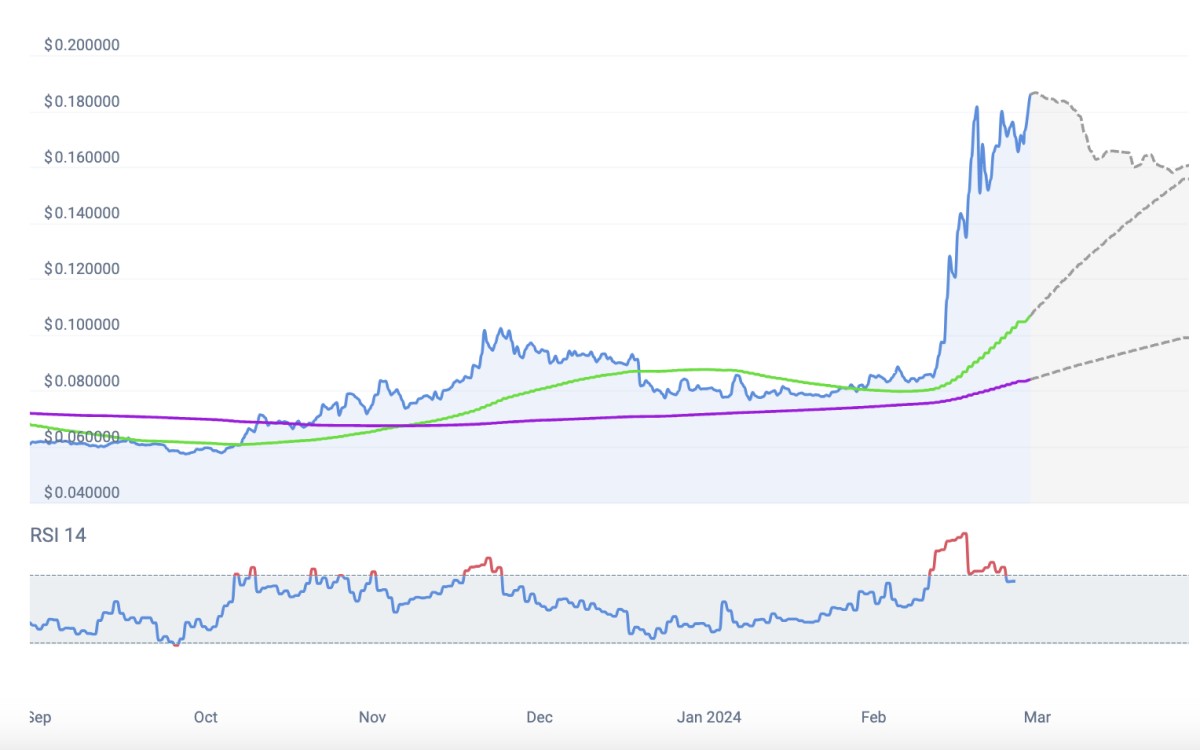
Based on data from 14 March 2024, the overall sentiment for Dogecoin's price prediction is optimistic. According to the technical indicators, we anticipate that Dogecoin's 200-day Simple Moving Average (SMA) will increase over the next month and reach $0.099385 by 13 April 2024. Additionally, it is projected that Dogecoin's short-term 50-day SMA will reach $0.156164 by the same date.
The Relative Strength Index (RSI) currently stands at a value of 67.04, indicating a neutral position in the DOGE market. Dogecoin support levels are estimated at $0.165621 and $0.162028, with the strongest level at $0.158056. Resistance levels for Dogecoin are predicted as $0.173186, $0.177158, and $0.180751.
Dogecoin (DOGE) price prediction for 2024, 2025 and 2030
Dogecoin has experienced both ups and downs at different times. The cryptocurrency does not boast many unique qualities, elements or technological solutions, and its last update took place back in 2015. Despite that, this cryptocurrency performs well and has a very welcoming and vibrant community, with Elon Musk as a top supporter. Given that the cryptocurrency market constantly sees an influx of new participants, newcomers' interest in Dogecoin is unlikely to wane. Let's look to the future and analyse the probable scenarios of Dogecoin's mid-term and long-term price prediction from cryptocurrency experts for 2024, 2025, and 2030.
TradingBeasts Dogecoin (DOGE) price prediction for 2024, 2025 and 2030
Per TradingBeasts' DOGE price prediction for 2024, the projected September price stands at $0.1702409, with an anticipated maximum of $0.2128011 and a minimum of $0.14470471. The average price prediction for December 2024 stands at $0.2079020. Looking ahead, January 2025 is predicted to see a price of $0.2081072, with December 2025 forecasted at $0.2113167. Further into the future, January 2027 is estimated at $0.2180249, while December 2025 is expected to reach $0.2268088.
WalletInvestor Dogecoin (DOGE) price prediction for 2024, 2025 and 2030
According to WalletInvestor's projections, Dogecoin (DOGE) 's price is expected to fluctuate over the coming years.
In December 2024, the forecast is $0.129, indicating a potential decrease from current levels. Looking further ahead, December 2025 sees a projected price of $0.0842, suggesting a significant decline compared to the previous year.
WalletInvestor anticipates a slight uptick in January 2029, with a forecasted price of $0.0868, followed by a dip to $0.0668 by March 2029.
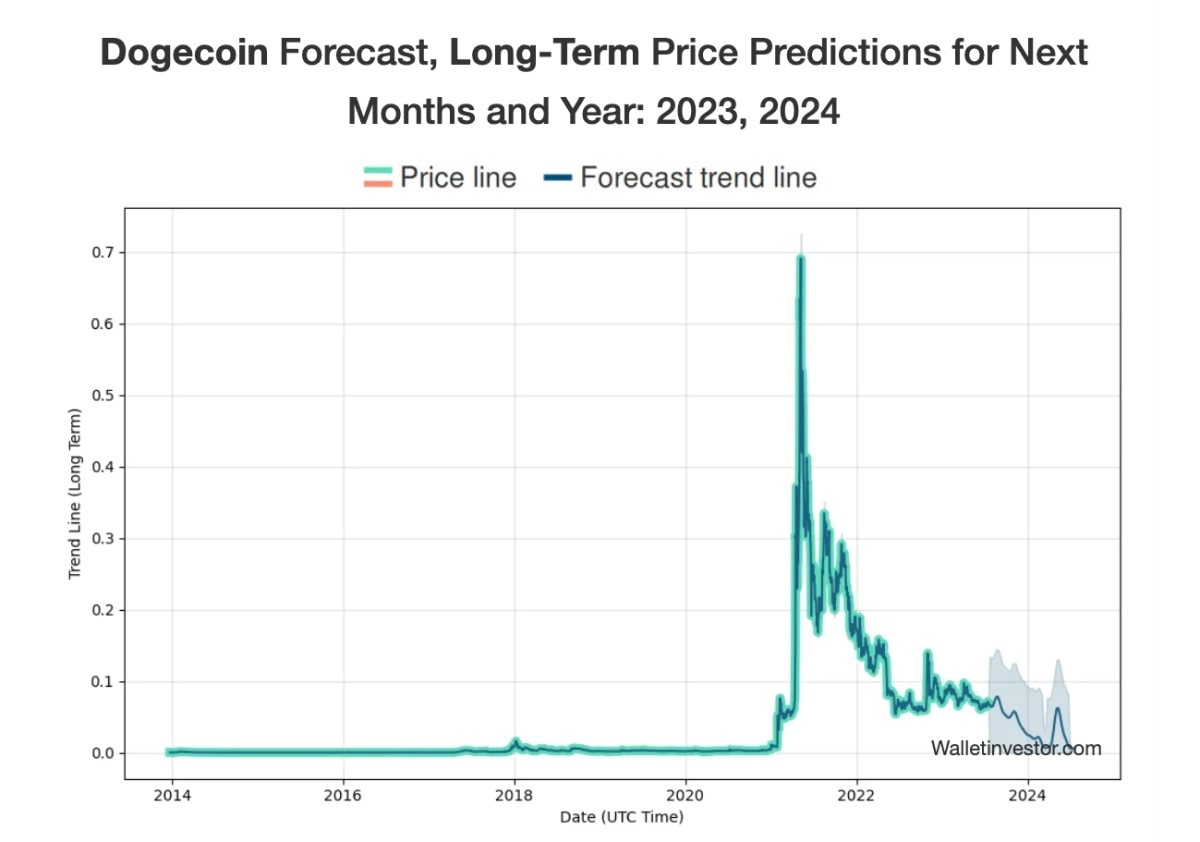
CoinSwitch Dogecoin (DOGE) price prediction for 2024, 2025 and 2030
CoinSwitch's Dogecoin price prediction for 2024 suggests a minimum value of $0.1439, emphasising potential stability. Looking ahead, experts estimate a maximum trading value of $0.1724, highlighting significant growth prospects for Dogecoin. In 2025, based on historical trends, Dogecoin could reach $0.2504, indicating further potential appreciation. For 2030, optimistic market conditions may lead to an average price of $1.24, reaching a peak of $1.44 or dropping to a minimum of $1.21 in a bearish market scenario.
Dogecoin (DOGE) overall value predictions in the future
Dogecoin is one of the oldest leading cryptocurrencies, with an active community supported by Elon Musk. According to experts, Dogecoin is a valuable buy. The digital asset is expanding its influence in e-commerce and is actively used as the default crypto for merchant payments, making the asset more attractive and valuable. Developers plan to bridge the Dogecoin network with Ethereum's, which will lead to even greater adoption.
Will Dogecoin (DOGE) go up?
Evaluating Dogecoin's growth potential, it's absolutely possible to say that this cryptocurrency has a wide range of possibilities. When a single tweet from Elon Musk can lead to an over 20% price increase in one day, imagine where a more targeted and serious approach may lead.
Dogecoin (DOGE) price prediction today
Today, Dogecoin's blockchain provides high transaction processing speed and extremely low fees, bypassing more successful projects in terms of capitalisation. Dogecoin is used in the modern world in many areas of business and society. It's used for charity, public events, and sports projects. Dogecoin has proven it's worthy of the legitimacy and credibility it's gained over time thanks to its active community, which gives ample opportunity for the project's future growth.
Tags
Try our Bitcoin Cloud Miner and get additional crypto rewards based on your trading volume. It's immediately available upon registration.
Try our Bitcoin Cloud Miner and get additional crypto rewards based on your trading volume. It's immediately available upon registration.



